Enjoying the pleasures of pipes past
Finding a vintage set
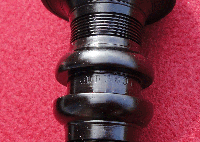
Acquiring a good set of vintage pipes can be a difficult and costly challenge. They can be found almost anywhere in the world, so it is rare that you will get to examine or play them before laying down your money. Online auction sites like eBay can list many at any given time, but purchasing here can be a fool’s game. It can be hard to determine the condition of a set of pipes from photos and descriptions provided by the seller. It is easy to make a regrettable purchase, not so much because a seller is shady (though some are), but because the seller may not be knowledgeable about pipes. The name of the maker may be a guess, and replacement parts and repairs can be nearly undetectable to an uneducated eye. Cracks may look like mere scratches, celluloid mistaken for ivory and German silver for Sterling. Many ebay sellers in the UK are estate dealers with no knowledge of bagpipes and a mandate to sell quickly.
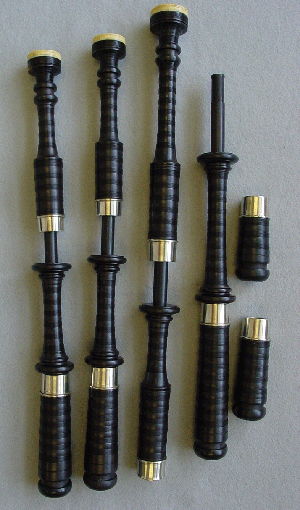
Often, sellers attach a maker to a set simply by what chanter is present, or by what the previous owner has told them. Sometimes a seller may used a particular stamped chanter to ‘improve’ the value of a bagpipe. These identifiers are not reliable. More than one ‘ivory’ set has been mounted in chalky casein, and more than one MacDougall set has been a Glen. More than one ‘entirely original’ set has had modern replica pieces replacing lost or broken parts (though often using the original mounts). More than a few ‘ebony’ sets have proven to be blackwood; some ‘cocuswood’ have turned out to be rosewood or laburnum. Some seemingly perfect sets of pipes have on delivery proven to be 3/4-sized sets which, in photos, look just like full-sized sets. Even experienced buyers may face deceptions of this kind from time to time.
Dates of manufacture are guesstimates at best unless there is a bill of sale or a clear family provenance. Hallmarked silver can be dated and can be a great help, though there is no guarantee that the silver is original to the pipes. It may be much older or much newer. Often a skilled pipemaker is required to determine if silver has been added later.
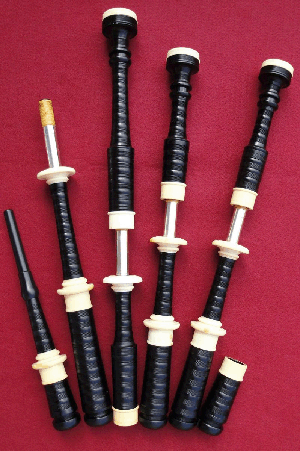
Confirming the make of a set of pipes can be important, but not paramount, unless price is affected by the prestige of an unauthenticated name. Sets that look like the work of an established maker, show superb craftsmanship and are in good shape will often exhibit top-notch tone. External quality often mirrors tonal traits. They may in fact be that make, though in good conscience you can’t really call them that without proof. Often, an experienced maker or buyer can get a sense from looking at a set whether it has good tonal potential. The appearance of the projecting mounts, ferrules, bells and drone tops tells a lot to an experiences buyer, and it is important that photos sent to a buyer include close-ups of these parts. Five shots of a complete bagpipe laying on a table six feet away are of little use.
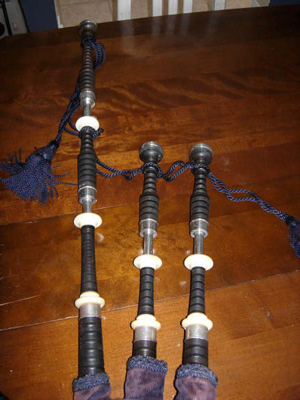
Wood is very important, both for its tonal properties and for what it tells about the age of the pipes. A bagpipe purported to be made in 1870, but that appears to be blackwood is likely bogus, since most pipes made at that time were ebony or cocuswood. A ‘pre-1840’ set with nickel mounts should also be questioned since nickel mounts came into use no earlier than the 1840s. If there are no seams in the nickel ferrules of a very early set, be very wary. Hallmarks on silver can be very helpful, but lots of silver on superb pipes was not hallmarked. And, again, there is no guarantee that the silver came with the pipes.
The verdict is split between whether ebony, cocuswood or blackwood makes the best pipes, but bore sizes are the determining factor, and how a bagpipe is made will trump wood selection every time. There is no substitute for being able to play a set of pipes for a week or so before you decide, though shipping, insurance and import duties and taxes assessed as pipes enter particular countries can mount substantially in transporting a costly set one or both ways.
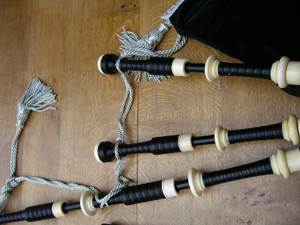
Replacement pieces are not necessarily a deal killer. An ebony set of Hendersons made in 1910 with a replica bass middle-joint will still be a magical instrument, but the fact that not all the major pieces are original will affect the value.
The same can be said for cracked pieces. A good pipemaker can repair a cracked drone piece or stock almost perfectly using glue, pinning or whipping (wrapping the piece with fine, strong cord). These repairs can also be rendered virtually invisible. The pipes will play as well as they ever played, though it should not be forgotten that wood shrinkage can affect bore size and slightly alter the tone in very early pipes. Such repairs done well will not affect the sound of the pipes. The value will be affected, but the truth is, as the era of ebony and cocuswood pipes recedes further back in history, the chances of finding instruments in these woods that haven’t cracked continue to drop. So be careful not to let a brilliant find pass you by because the instrument is not ‘perfect.’ Very, very few are.
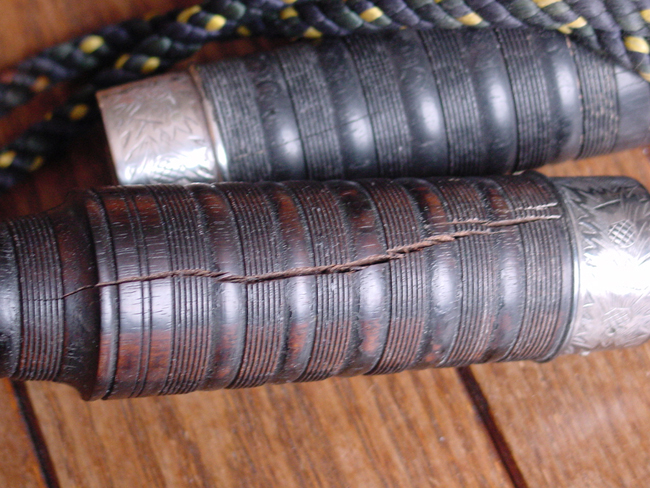

I’m surprised there are not a number of comments or questions on this article – a lot of information, experience and work in the article, much of which was new to me. So glad the article was retrieved!